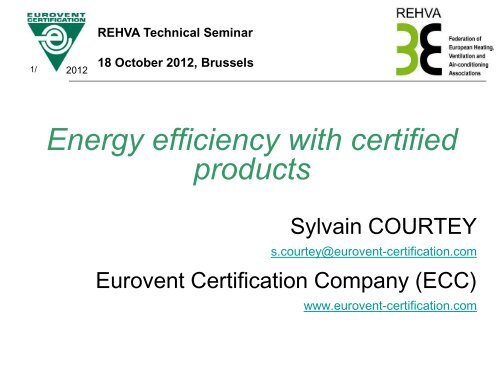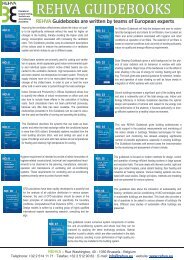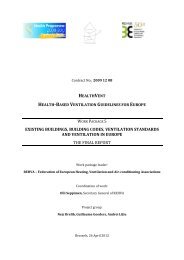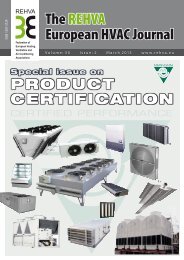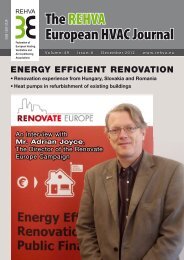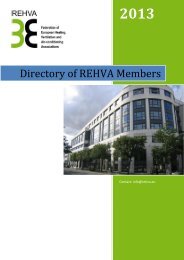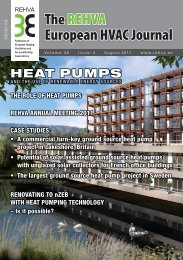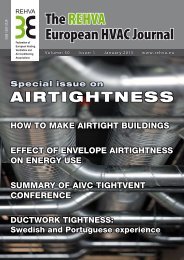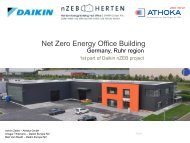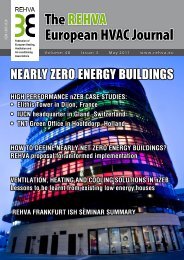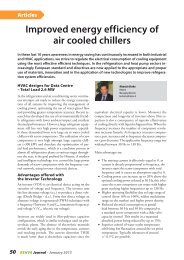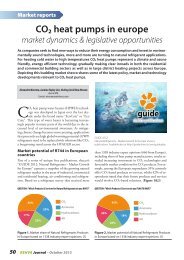Energy efficiency with certified products, Eurovent Certification - rehva
Energy efficiency with certified products, Eurovent Certification - rehva
Energy efficiency with certified products, Eurovent Certification - rehva
Create successful ePaper yourself
Turn your PDF publications into a flip-book with our unique Google optimized e-Paper software.
REHVA Technical Seminar<br />
1/ 2012<br />
18 October 2012, Brussels<br />
<strong>Energy</strong> <strong>efficiency</strong> <strong>with</strong> <strong>certified</strong><br />
<strong>products</strong><br />
Sylvain COURTEY<br />
s.courtey@eurovent-certification.com<br />
<strong>Eurovent</strong> <strong>Certification</strong> Company (ECC)<br />
www.eurovent-certification.com
REHVA Technical Seminar<br />
2/ 2012<br />
18 October 2012, Brussels<br />
1. Review of existing <strong>certified</strong><br />
energy performances<br />
2. How to use <strong>certified</strong> energy<br />
performances?
3/ 2012<br />
1. <strong>Energy</strong> index:<br />
<strong>Energy</strong> performances?<br />
‣ What you get / what you expense.<br />
Ex: EER, COP, ESEER, …<br />
2. Annual energy consumption:<br />
‣ In kWh/annum<br />
3. <strong>Energy</strong> <strong>efficiency</strong> classes:<br />
‣ Ex: A, B, C, …
4/ 2012<br />
EU energy label for<br />
residential AC<br />
• Commission Delegated Regulation (EU) No<br />
626/2011 supplementing Directive<br />
2010/30/EU published on 4 May 2011<br />
• For cooling only and reversible residential<br />
AC up to 12 kW<br />
• Based on seasonal efficiencies<br />
(SEER & SCOP)<br />
• Efficiency in heating mode (SCOP) depends<br />
on the climate (warm, average or cold)<br />
• Label to be applied from 1st January 2013<br />
• Certified performances available at<br />
www.eurovent-certification.com in Jan 2013
5/ 2012<br />
EU energy label for<br />
residential ventilation units<br />
• Draft commission working document<br />
(10 Oct 2012)<br />
• Publication in 2013?<br />
• For residential ventilation units <strong>with</strong> fan<br />
power input
6/ 2012<br />
ECC energy label for<br />
chillers and heat-pumps<br />
• <strong>Eurovent</strong> energy classes available<br />
since 2004<br />
• Rating system was changed in 2011<br />
according to EN14511:2011<br />
• Take into account the proportional<br />
heat given off from fans and<br />
pumps: pressure drop in the HE is<br />
taken into account (system<br />
approach)<br />
• Different from the US approach<br />
(AHRI 550/590) for which only the<br />
thermodynamic <strong>efficiency</strong> is<br />
considered (gross performances)
7/ 2012<br />
ECC energy label for<br />
chillers and heat-pumps<br />
Pc gross<br />
<strong>with</strong>out<br />
integral<br />
pump<br />
Pc acc.<br />
EN14511:2011<br />
Pump contribution in<br />
the unit =(Qv*∆p)/η<br />
Pump contribution to the<br />
ductwork =(Qv*ESP)/η<br />
• EER EN14511:2011 ≈ 98.5% (±6) * EER gross<br />
• COP EN14511:2011 ≈ 98.6% (±10) * COP gross<br />
(source: www.eurovent-certification.com)
8/ 2012<br />
Seasonal <strong>efficiency</strong><br />
for chillers: ESEER<br />
ESEER=0.03*EER100%+0.33*EER75%+0.41*EER50%+0.23*EER25%<br />
Lot 6: Air-conditioning and ventilation systems – Air conditioning systems – Final report of Task 7 (July 2012) – www.ecohvac.eu
Air handling units<br />
9/ 2012<br />
• Interrelationships to evaluate the energy <strong>efficiency</strong><br />
of AHU are complex and even depend on climate<br />
conditions<br />
• One single letter to represent<br />
balanced effects of:<br />
‣ Air velocity in the fan section (V)<br />
‣ Heat recovery <strong>efficiency</strong> and<br />
pressure drop (η)<br />
‣ Fan <strong>efficiency</strong> (f)
10/ 2012<br />
Air handling units<br />
• Three classifications for three<br />
subgroup of <strong>products</strong>:<br />
‣ Design outdoor temperature < 9°C<br />
(HRS will significantly save energy)<br />
‣ Design outdoor T > 9°C : N<br />
‣ Single extract units : h<br />
• Six classes from A to
11/ 2012<br />
ECC energy label for<br />
Fan Coil Units<br />
• Available since 2011<br />
• First energy label for FCU<br />
in the world!<br />
• Weighted average of performance of<br />
low, medium and high speeds<br />
FCEER<br />
5% Pc<br />
<br />
5% Pe(<br />
c)<br />
high<br />
high<br />
30% Pc<br />
med<br />
30% Pe(<br />
c)<br />
med<br />
65% Pc<br />
low<br />
65% Pe(<br />
c)<br />
low<br />
5% Ph<br />
FCCOP <br />
5% Pe(<br />
h)<br />
high<br />
high<br />
25% Ph<br />
• Consider both sensible and latent<br />
capacities<br />
• Certified data available at:<br />
www.eurovent-certification.com<br />
med<br />
25% Pe(<br />
h)<br />
med<br />
70% Ph<br />
low<br />
70% Pe(<br />
h)<br />
low
12/ 2012<br />
1200<br />
1000<br />
800<br />
ECC energy label for<br />
Fan Coil Units<br />
Others<br />
Variable speed fan<br />
600<br />
400<br />
200<br />
0<br />
G F E D C B A<br />
Classes A and B only achieved by variable speed fan units
13/ 2012<br />
ECC energy label for<br />
Air Filters<br />
• Available since 2011<br />
• First energy label for<br />
air filters in the world!<br />
• Based on average pressure drop<br />
measured during an EN779 test<br />
• Estimated annual energy consumption<br />
in kWh/year is given<br />
Where qv = 0.944 m³/s ; t = 6000 h and η = 0.50<br />
• Certified data available at:<br />
www.eurovent-certification.com
14/ 2012<br />
ECC energy label for<br />
Air Filters<br />
Filter class<br />
G4 M5 M6 F7 F8<br />
F9<br />
MTE<br />
— — — MTE ≥ 35% MTE ≥ 55% MTE ≥ 70%<br />
M G = 350 g ASHRAE M M = 250 g ASHRAE M F = 100 g ASHRAE<br />
A 0 – 600 kWh 0 – 650 kWh 0 – 800 kWh 0 – 1200 kWh 0 – 1600 kWh 0 – 2000 kWh<br />
B > 600 kWh – 700 kWh > 650 kWh – 780 kWh > 800 kWh – 950 kWh > 1200 kWh – 1450 kWh > 1600 kWh – 1950 kWh > 2000 kWh – 2500 kWh<br />
C > 700 kWh – 800 kWh > 780 kWh – 910 kWh > 950 kWh – 1100 kWh > 1450 kWh – 1700 kWh > 1950 kWh – 2300 kWh > 2500 kWh – 3000 kWh<br />
D > 800 kWh – 900 kWh > 910 kWh – 1040 kWh > 1100 kWh – 1250 kWh > 1700 kWh – 1950 kWh > 2300 kWh – 2650 kWh > 3000 kWh – 3500 kWh<br />
E > 900 kWh – 1000 kWh > 1040 kWh – 1170 kWh > 1250 kWh – 1400 kWh > 1950 kWh – 2200 kWh > 2650 kWh – 3000 kWh > 3500 kWh – 4000 kWh<br />
F > 1000 kWh – 1100 kWh > 1170 kWh – 1300 kWh > 1400 kWh – 1550 kWh > 2200 kWh – 2450 kWh > 3000 kWh – 3350 kWh > 4000 kWh – 4500 kWh<br />
G<br />
> 1100 kWh > 1300 kWh > 1550 kWh > 2450 kWh > 3350 kWh > 4500 kWh<br />
• <strong>Energy</strong> <strong>efficiency</strong> only defined for filters fulfilling minimum<br />
discharge <strong>efficiency</strong> given in EN779:2012<br />
• Method described in <strong>Eurovent</strong> 4/11<br />
available at: www.eurovent-association.eu
15/ 2012<br />
ECC energy label for<br />
Air Filters<br />
Important notice:<br />
Filtration <strong>efficiency</strong> shall be chosen before <strong>Energy</strong> <strong>efficiency</strong>!<br />
1. Targeted indoor air quality shall be defined<br />
2. Filters shall be chosen according to international guidelines<br />
(e.g.: EN13779):<br />
3. <strong>Energy</strong> <strong>efficiency</strong> shall be defined according to <strong>Eurovent</strong> 4/11
Overview of energy labels &<br />
performances for HVAC <strong>products</strong><br />
Res.<br />
16/ 2012<br />
Product<br />
AC12kW<br />
AHU<br />
Fan Coils<br />
?<br />
2010<br />
?<br />
2008<br />
2011<br />
2013<br />
2015?<br />
2015?<br />
2015?<br />
2015?<br />
2013<br />
2007<br />
1995<br />
2007<br />
1995<br />
η<br />
(S)EER, (S)COP<br />
(S)EER, (S)COP<br />
(S)EER, (S)COP<br />
f(V,η,∆p,f)<br />
FCEER, FCCOP<br />
Air Filters<br />
2012<br />
2007<br />
An. En. Cons<br />
HEx<br />
2005<br />
2001<br />
R
Res.<br />
17/ 2012<br />
Products<br />
AC12kW<br />
AHU<br />
Fan Coils<br />
Air Filters<br />
HEx<br />
Non Residential <strong>products</strong> <strong>with</strong> high energy<br />
? saving potentials:<br />
EU MEPS (push) and voluntary labels (pull)<br />
(Exception <strong>with</strong> Fans)<br />
?<br />
Other Non Residential <strong>products</strong>: only voluntary<br />
certification (driven by the market)
REHVA Technical Seminar<br />
18/ 2012<br />
18 October 2012, Brussels<br />
1. Review of existing <strong>certified</strong><br />
energy performances<br />
2. How to use <strong>certified</strong> energy<br />
performances?
19/ 2012<br />
French building energy<br />
regulation “RT 2012”<br />
• How does it work?<br />
o<br />
o<br />
o<br />
Computerized building simulation tool<br />
Heat transfer calculation on an hourly basis<br />
Need to be fed <strong>with</strong> HVAC <strong>products</strong> characteristics<br />
• Examples of inputs<br />
o<br />
o<br />
Efficiencies of cooling/heating generators<br />
Heat recovery <strong>efficiency</strong>
20/ 2012<br />
French building energy<br />
regulation « RT 2012 »<br />
• Cooling/heating generators<br />
Efficiencies are required as inputs<br />
(e.g.: COP for heat-pumps)<br />
• Four levels of performances are considered<br />
Efficiency (EER, COP) is:<br />
Certified by a certification body<br />
accredited according to EN45011<br />
Justified by a laboratory<br />
accredited according to ISO17025<br />
Self declared<br />
Not available<br />
Value considered in the simulation tool<br />
100%*Declared Value<br />
90%*Declared Value<br />
Min (80%*Declared Value, Default Value)<br />
80% * Default Value
21/ 2012<br />
French building energy<br />
regulation « RT 2012 »<br />
• Ventilation:<br />
Heat recovery efficiencies are required as inputs<br />
(in %-point)<br />
• Three levels of performances are considered:<br />
Efficiency of the heat-recovery<br />
system is:<br />
Certified by a certification body<br />
accredited according to EN45011<br />
Justified by a laboratory<br />
accredited according to ISO17025<br />
Self declared<br />
Value considered in the simulation tool<br />
100%*Declared Value<br />
90%*Declared Value<br />
Min (80%*Declared Value, Default Value)
22/ 2012<br />
White certificates<br />
• French white certificate scheme (Certificat<br />
d’Econome d’Energie – CEE)<br />
o<br />
o<br />
o<br />
By law energy suppliers are obliged to help their<br />
customers to save energy.<br />
« Saved energy » is the number of kWh saved over<br />
the lifetime of the product / equipment generating the<br />
savings.<br />
Standard operations are defined by public authorities
23/ 2012<br />
White certificates<br />
• Example of standard operation for Fan Coil units<br />
(BAT-TH-43)<br />
o<br />
o<br />
o<br />
o<br />
Refurbishment of old FCUs by new ones<br />
In tertiary buildings <strong>with</strong> heated and/or cooled surface<br />
< 5000 m²<br />
New FCUs shall be <strong>Eurovent</strong> class A<br />
Certified by <strong>Eurovent</strong> or a certification body<br />
accredited according to EN45011 or justified by<br />
independant laboratory accredited according to<br />
ISO17025
24/45 2012<br />
Other fiscal incentive<br />
initiatives<br />
• The Netherlands<br />
‣ Government Capital Rebate programme for Air Handling<br />
units <strong>with</strong> <strong>certified</strong> A product<br />
• Spain<br />
‣ Government incentives for High Efficiency Refrigeration<br />
Display Cabinets (<strong>Energy</strong> Class A & B only)
25/ 2012<br />
Where <strong>certified</strong> data<br />
can be used?<br />
Local tax incentives<br />
National implementation of<br />
EPBD<br />
Building energy labels<br />
Green public<br />
procurements<br />
White certificates
26/ 2012<br />
Conclusion and perspectives<br />
• EU MEPS and voluntary energy labels work together (push and<br />
pull)<br />
• <strong>Energy</strong> labels for HVAC <strong>products</strong> are a powerful marketing tool<br />
but also a useful regulation tool<br />
• In all cases, the best practice is as follows:<br />
1. Good design (avoid oversizing) ask for <strong>certified</strong><br />
performances<br />
2. Good energy <strong>efficiency</strong> ask for <strong>certified</strong><br />
A class
27/ 2012<br />
Thank you for your attention


